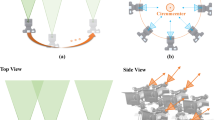Abstract
Block matching along epipolar lines is the core of most stereovision algorithms in geographic information systems. The usual distances between blocks are the sum of squared distances in the block (SSD) or the correlation. Minimizing these distances causes the fattening effect, by which the center of the block inherits the disparity of the more contrasted pixels in the block. This fattening error occurs everywhere in the image, and not just on strong depth discontinuities. The fattening effect at strong depth edges is a particular case of fattening, called foreground fattening effect. A theorem proved in the present paper shows that a simple and universal adaptive weighting of the SSD resolves the fattening problem at all smooth disparity points (a Spanish patent has been applied for by Universitat de Illes Balears (Reference P25155ES00, UIB, 2009)). The optimal SSD weights are nothing but the inverses of the squares of the image gradients in the epipolar direction. With these adaptive weights, it is shown that the optimal disparity function is the result of the convolution of the real disparity with a prefixed kernel. Experiments on simulated and real pairs prove that the method does what the theorem predicts, eliminating surface bumps caused by fattening. However, the method does not resolve the foreground fattening.
Similar content being viewed by others
References
Buades, A., Coll, B., Morel, J.M., Rouge, B.: Procedimiento de establecimiento de correspondencia entre una primera imagen digital y una segunda imagen digital de una misma escena para la obtencion de disparidades. Spanish Patent, Reference P25155ES00, UIB (2009)
Cao, F.: A Theory of Shape Identification. Springer, Berlin (2008)
Cao, F., Delon, J., Desolneux, A., Muse, P., Sur, F.: A unified framework for detecting groups and application to shape recognition. J. Math. Imaging Vis. 27(2), 91–119 (2007)
Delon, J., Rougé, B.: Small baseline stereovision. J. Math. Imaging Vis. 28(3), 209–223 (2007)
Fusiello, A., Roberto, V., Trucco, E.: Symmetric stereo with multiple windowing. Int. J. Pattern Recognit. Artif. Intell. 14(8), 1053–1066 (2000)
Hirschmuller, H., Innocent, P.R., Garibaldi, J.: Real-time correlation-based stereo vision with reduced border errors. Int. J. Comput. Vis. 47(1-3), 229–246 (2002)
Kanade, T., Okutomi, M.: A stereo matching algorithm with an adaptive window: Theory and experiment. IEEE Trans. Pattern Anal. Mach. Intell. 16(9), 920–932 (1994)
Kimmel, R., Zhang, C., Bronstein, A.M., Bronstein, M.M.: Are mser features really interesting? IEEE Pami. In press (2010)
Lotti, J., Giraudon, G.: Correlation algorithm with adaptive window for aerial image in stereo vision. In: Image and Signal Processing for Remote Sensing, vol. 2315, pp. 76–87 (1994)
Lowe, D.: Distinctive image features from scale-invariant keypoints. Int. J. Comput. Vis. 60(2), 91–110 (2004)
Matas, J., Chum, O., Urban, M., Pajdla, T.: Robust wide-baseline stereo from maximally stable extremal regions. Image Vis. Comput. 22(10), 761–767 (2004)
Mikolajczyk, K., Tuytelaars, T., Schmid, C., Zisserman, A., Matas, J., Schaffalitzky, F., Kadir, T., Gool, L.V.: A comparison of affine region detectors. Int. J. Comput. Vis. 65(1), 43–72 (2005)
Morel, J.M., Yu, G.: ASIFT: A new framework for fully affine invariant image comparison. SIAM J. Imaging Sci. 2(2), 438–469 (2009)
Musé, P., Sur, F., Cao, F., Gousseau, Y., Morel, J.-M.: An a contrario decision method for shape element recognition. Int. J. Comput. Vis. 69(3), 295–315 (2006)
Patricio, M.P., Cabestaing, F., Colot, O., Bonnet, P.: A similarity-based adaptive neighborhood method for correlation-based stereo matching. In: International Conference on Image Processing, vol. 2, pp. 1341–1344 (2004)
Robert, L., Faugeras, O.D.: Curve-based stereo: figural continuity and curvature. In: IEEE Computer Society Conference on Computer Vision and Pattern Recognition (1991)
Sabater, N.: Reliability and accuracy in stereovision. Application to aerial and satellite high resolution images. Ph.D. thesis, ENS Cachan, December (2009)
Sabater, N., Blanchet, G., Moisan, L., Almansa, A., Morel, J.-M.: Review of low-baseline stereo algorithms and benchmarks. In: Image and Signal Processing for Remote Sensing XVI, vol. 7830 (2010)
Scharstein, D., Szeliski, R.: Middlebury stereo vision page. Online at http://www.middlebury.edu/stereo (2002)
Scharstein, D., Szeliski, R.: A taxonomy and evaluation of dense two-frame stereo correspondence algorithms. Int. J. Comput. Vis. 47(1/2/3), 7–42 (2002)
Schmid, C., Zisserman, A.: The geometry and matching of lines and curves over multiple views. Int. J. Comput. Vis. 40(3), 199–234 (2000)
Tomasi, C., Manduchi, R.: Bilateral filtering for gray and color images. In: Proceedings of the Sixth International Conference on Computer Vision, vol. 846 (1998). CiteSeer
Veksler, O.: Fast variable window for stereo correspondence using integral images. IEEE Comput. Soc. Conf. Comput. Vis. Pattern Recognit. 1, 556–561 (2003)
Wang, L., Liao, M., Gong, M., Yang, R., Nister, D.: High-quality real-time stereo using adaptive cost aggregation and dynamic programming. In: Proceedings of the Third International Symposium on 3D Data Processing, Visualization, and Transmission, pp. 798–805 (2006)
Yaroslavsky, L., Eden, M.: Fundamentals of digital optics (2003)
Yoon, K.-J., Kweon, I.S.: Adaptive support-weight approach for correspondence search. IEEE Trans. Pattern Anal. Mach. Intell. 28(4), 650–656 (2006)
Author information
Authors and Affiliations
Corresponding author
Additional information
This work was partially financed by spanish government MCYIT grant number TIN2008-04752.
Rights and permissions
About this article
Cite this article
Blanchet, G., Buades, A., Coll, B. et al. Fattening Free Block Matching. J Math Imaging Vis 41, 109–121 (2011). https://doi.org/10.1007/s10851-011-0268-0
Published:
Issue Date:
DOI: https://doi.org/10.1007/s10851-011-0268-0




